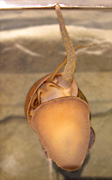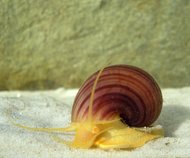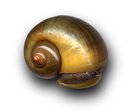Ampullariidae
|
|
The Family Ampullariidae (Pilidae)—commonly referred to as Apple Snails—are tropical and subtropical freshwater mollusks. The Ampullariidae includes several genera: Asolene, Felipponea, Marisa, and Pomacea are New World genera (native to South America, Central America, the West Indies and the Southern U.S.A.), while the genera Afropomus, Lanistes, and Saulea are found in Africa. The genus Pila is native to both Africa and Asia.
| Contents |
Adaptations
Apple snails are exceptionally well adapted to tropical regions characterized by periods of drought alternating with periods of high rainfall. This adaptation is reflected in their life style: moderately amphibious and being equipped with a shell "door" enabling the snail to close itself off in the shell to prevent drying out while hiding in the mud during dry periods.Pomacea_canaliculata_eggsonhand.jpg
P. canaliculata eggs
One of the more typical adaptations of apple snails is the branchial respiration system comparable with the gills of a fish (at the right side of the snail body) to breathe under water as well as a lung (at the left side of the body) to respirate air. This lung/gill combination expands the action radius of the snail in search for food. It's part of their natural behaviour to leave the water when the food supply below the surface is inadequate. Several apple snail genera (Pomacea, Pila and Asolene/Pomella) deposit eggs above the waterline in calcareous clutches. This remarkably strategy of aquatic snails protect the eggs against predation by fish and other aquatic inhabitants. Another anti-predator adaptation in the apple snail genera Pomacea and Pila, is the tubular siphon, used to breathe air while submerged, reducing vulnerability to attacking birds. Apple snails inhabit various ecosystems: ponds, swamps and rivers. Although they occasionally leave the water, they mainly spend time in the water. Unlike many snail species, apple snails are not hermaphroditic, but gonochoristic: a male and a female are needed for reproduction.
Common aquarium pet
Apple snails are popular aquarium-pets because of their attractive appearance and size. When taken good care of some apple snail species can reach 15 cm / 6 inch diameter. Apple snails are in fact the biggest living freshwater snails on earth. The most common apple snail in aquarium shops is Pomacea bridgesii (spike-topped apple snail). This species comes in different colours from brown to albino or yellow and even blue, with or without banding. Another common apple snail is Pomacea canaliculata, this snail is bigger, rounder and is more likely to eat aquatic plants, which makes it less suitable for most aquaria. This species also come in different shell and body colours. The Giant ramshorn snail, Marisa cornuarietis, although not always recognized as an apple snail due to its discoidal shape, also ranks the popular aquatic pets. Occasionally, the Florida apple snail (Pomacea paludosa) is found in the aquarium trade and are often wild collected from ditches and ponds in Florida. The giant Pomacea maculata, rarely finds its way into aquaria. Apple snails are often sold under the name Golden mystery snail and they are given incorrect names like Ampullarius for the genus instead of Pomacea and wrong species names like gigas instead of maculata.
A pest
In the 1980s, the genus Pomacea (Pomacea canaliculata) was introduced in Taiwan to start an escargot industry. Such food culture could provided valuable proteins for farmers, who primary live on a rice diet. However, the snails didn't become a culinary success. The imported snails are able to transfer Angiostrongylus cantonensis (like the native apple snail population, Pila), a parasite that infects humans when the snails aren't cooked thoroughly. Instead of becoming a food source they escaped, and became a serious threat to rice production and the environment. During the 1980s the introduced snails rapidly spread to Indonesia, Thailand, Cambodia, Hong Kong, southern China, Japan and the Philippines and there are indications that they are currently invading Australia. Hawai'i experienced the same introduction of Pomacea for culinary purposes, and its taro industry is now suffering because of it. Nevertheless, apple snails are considered a delicacy in several regions and they are often sold in Oriental markets for consumption.
Bio-control
Pomacea and Marisa species have been introduced to Africa and Asia to control snails (Planorbidae: Bulinus sp. and Biophalaria sp.) that serve as an intermediate host for trematoda parasites. These parasites can cause swimmers itch and schistosomiasis, a disease that affects over 200 million people in tropical regions. One of the species introduced as bio-agent is Marisa cornuarietis. This snail competes with other snails and predates on other species. Hopefully Marisa will not develop into a pest as have Pomacea species in Asia.
External link
- Applesnail website (http://www.applesnail.net)



